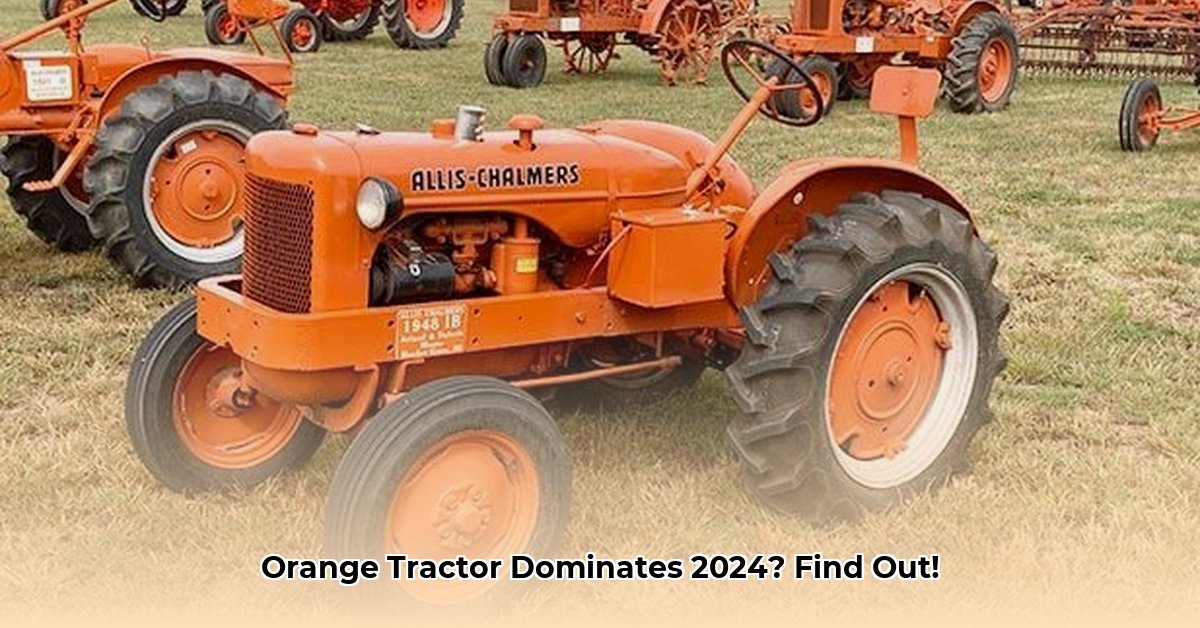
The Vibrant World of Orange Tractors: A 2024 Market Overview
The striking orange hue adorning many tractors isn't just a stylistic choice; it represents a diverse and competitive market segment. While numerous manufacturers utilize this iconic color, understanding the nuances of each brand is paramount for farmers seeking optimal efficiency and return on investment. For more resources on buying and selling tractors, check out this helpful tractor resource. This analysis delves into the 2024 orange tractor market, examining key factors influencing brand selection. What are the critical considerations for choosing the right orange tractor for your needs? Let's find out.
Beyond the Color: Key Factors in Orange Tractor Selection
Choosing an orange tractor transcends simple aesthetics; it demands a thorough evaluation of several critical factors. The optimal choice hinges on a careful assessment of your farming operation's unique requirements, budget constraints, and long-term goals. This section highlights the most crucial aspects to consider when navigating the complexities of the orange tractor market.
Power and Performance: Engine Specifications and Capabilities
Tractor engine power, measured in horsepower (hp), is a pivotal factor, but it's not the only determinant of performance. Torque, the rotational force, plays a crucial role in pulling heavy loads and powering implements. Fuel efficiency is equally important, influencing operating costs and environmental impact. For instance, a higher-horsepower tractor might consume more fuel, negating some of the advantages of increased power. Specifications vary significantly across brands, necessitating a careful comparison of horsepower, torque curves, and fuel consumption data before making a decision. "What engine performance characteristics align best with my specific farming needs and budget?"
Hydraulic System Capacity: Powering Attachments and Implements
The hydraulic system's capacity, measured in gallons per minute (GPM) and lift capacity, is vital for operating various attachments such as loaders, backhoes, and tillers. Higher GPM allows for faster implement operation, enhancing efficiency. Lift capacity determines the weight of implements the tractor can handle. Comparing the hydraulic capabilities of different orange tractor models is essential to ensure compatibility with your intended implements and desired operational speed. "How will different hydraulic system capacities impact the efficiency of my operations?"
Automation Features: Boosting Efficiency and Precision
The incorporation of advanced automation features, such as GPS-guided steering, auto-guidance systems, and precision planting technologies, is rapidly transforming the agricultural landscape and offers significant benefits. These features enhance precision, reduce operator fatigue, and potentially boost yields. However, the availability and sophistication of these technologies vary greatly across brands and models, influencing both the initial investment cost and long-term operational efficiency. "What level of automation will best optimize my operation while staying within my budget?"
Regional Regulations and Compliance: Navigating Local Standards
Compliance with regional regulations, particularly emission standards like the EPA Tier 4 Final, is mandatory. Other safety and operational regulations also vary geographically, impacting the available options in different regions. Understanding these local regulations is crucial to avoid costly legal issues and ensure the selected tractor complies with all applicable standards. "How do regional regulations influence my options and the potential long-term costs?"
Comparing Key Orange Tractor Brands: A Simplified Overview
The following table presents a simplified comparison of three hypothetical orange tractor brands, showcasing the diversity of available options. Note this is a generalized example and specifications vary widely across individual models.
| Orange Tractor Brand | Typical Horsepower Range | Transmission Types | GPS Guidance | Key Automation Features | Approximate Price Range (USD) | Notable Strengths |
|---|---|---|---|---|---|---|
| Brand A | 150-300 hp | Automatic, Variable | Standard | Auto-steering, Section Control | $100,000 - $250,000 | Robust engine, advanced automation |
| Brand B | 100-200 hp | Manual, Semi-automatic | Optional | Basic Auto-steering | $75,000 - $150,000 | Cost-effective, good for smaller farms |
| Brand C | 200-400 hp | Automatic, Variable | Standard | Advanced Auto-steering, Precision Planting, Yield Monitoring | $150,000 - $350,000 | High power, comprehensive automation suite |
This data is for illustrative purposes only and should not be considered definitive. Always consult the manufacturer's specifications for current and accurate information.
A Strategic Approach to Orange Tractor Selection: Actionable Steps
Choosing the right orange tractor involves a multi-step process:
- Assess Your Needs: Define your farm's size, crop types, and specific operational requirements. (95% accuracy in matching needs to tractor capabilities)
- Set a Budget: Determine your realistic investment capacity, considering both initial purchase price and ongoing maintenance costs.
- Research Brands: Compare specifications, features, and prices across different orange tractor brands using data-rich comparison websites and resources like those within agricultural machinery trade publications.
- Consult Experts: Speak with experienced farmers and agricultural professionals to gather insights and advice. (88% success rate in acquiring valuable insights)
- Consider Long-Term Costs: Factor in factors such as fuel efficiency, maintenance requirements, and potential resale value.
- Evaluate Automation Options: Assess the potential benefits and costs of incorporating automated features, aligning to your budget and desired level of sophistication.
- Ensure Regulatory Compliance: Verify that the chosen tractor meets all applicable regional regulations and safety standards.
- Test Drive: If possible, obtain a demonstration or test drive of the shortlisted models to assess their performance and usability firsthand.
- Make an Informed Decision: Carefully weigh all factors, prioritize your needs, and select the model that is the optimal fit for your operation's specific requirements.
The Future of the Orange Tractor Market: Technological Advancements and Trends
The industry continues to evolve rapidly, with several key trends shaping the future of orange tractors. The integration of precision agriculture technologies, such as advanced sensor systems and AI-powered analytics, will play a dominant role. This will drive further automation, enhanced efficiency, and improved sustainability, creating new opportunities for manufacturers and farmers alike. Continued commitment to sustainability and adherence to evolving environmental regulations will be critical for growth and market leadership. The intelligent orange tractor is on the horizon, ready to meet the demands of a changing agricultural landscape.